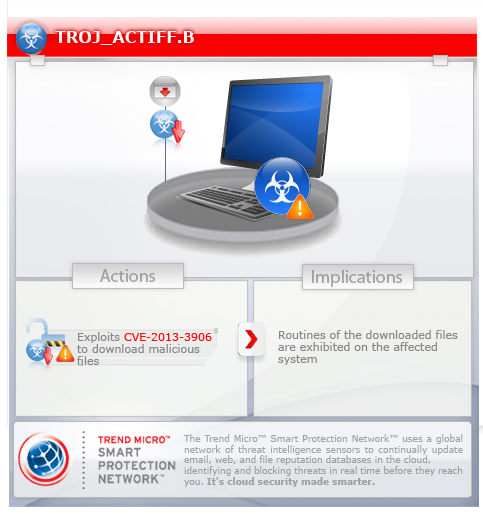TROJ_ACTIFF.B
Exploit:Win32/CVE-2013-3906 (Microsoft); Trojan.Hantiff (Symantec); Exploit-CVE2013-3906 (McAfee)
Windows 2000, Windows Server 2003, Windows XP (32-bit, 64-bit), Windows Vista (32-bit, 64-bit), Windows 7 (32-bit, 64-bit)


Threat Type: Trojan
Destructiveness: No
Encrypted: Yes
In the wild: Yes
OVERVIEW
Downloaded from the Internet, Dropped by other malware
This malware is involved in the targeted attacks that took advantage of an unpatched Microsoft Office vulnerability, namely CVE-2013-3906, on November 2013. Victims of this malware may find the security of their systems compromised.
To get a one-glance comprehensive view of the behavior of this Trojan, refer to the Threat Diagram shown below.

This Trojan arrives on a system as a file dropped by other malware or as a file downloaded unknowingly by users when visiting malicious sites.
It executes the downloaded files. As a result, malicious routines of the downloaded files are exhibited on the affected system. As of this writing, the said sites are inaccessible.
TECHNICAL DETAILS
309,846 bytes
DOCX
06 Nov 2013
Downloads files
Arrival Details
This Trojan arrives on a system as a file dropped by other malware or as a file downloaded unknowingly by users when visiting malicious sites.
Download Routine
This Trojan takes advantage of the following software vulnerabilities to download possibly malicious files:
- CVE-2013-3906
After successfully exploiting the said vulnerability, this malware connects to the following URLs to possibly download other malicious files:
- http://{BLOCKED}net.com/bruce/winword.exe
- http://{BLOCKED}net.com/ralph_3/winword.exe
It saves the files it downloads using the following names:
- %User Temp%\winword.exe
(Note: %User Temp% is the current user's Temp folder, which is usually C:\Documents and Settings\{user name}\Local Settings\Temp on Windows 2000, XP, and Server 2003, or C:\Users\{user name}\AppData\Local\Temp on Windows Vista and 7.)
It then executes the downloaded files. As a result, malicious routines of the downloaded files are exhibited on the affected system.
As of this writing, the said sites are inaccessible.
Other Details
More information on this vulnerability can be found below:
SOLUTION
9.200
10.394.05
06 Nov 2013
10.395.00
06 Nov 2013
Step 1
Before doing any scans, Windows XP, Windows Vista, and Windows 7 users must disable System Restore to allow full scanning of their computers.
Step 2
Search and delete this file
- %User Temp%\winword.exe
Step 3
Scan your computer with your Trend Micro product to delete files detected as TROJ_ACTIFF.B. If the detected files have already been cleaned, deleted, or quarantined by your Trend Micro product, no further step is required. You may opt to simply delete the quarantined files. Please check this Knowledge Base page for more information.
NOTES:
Download Fix-it Tool released by vendor to temporarily address the issue:
Did this description help? Tell us how we did.

